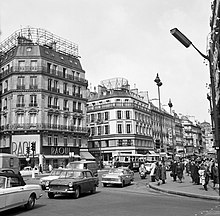You can help expand this article with text translated from the corresponding article in French. (December 2020) Click for important translation instructions.
|
| Les Trente Glorieuses | |||
|---|---|---|---|
| 1945–1975 | |||
 | |||
| Location | France | ||
| Key events | Suez Crisis | ||
| Chronology | |||
| Part of a series on the | ||||||||||||||||||||
|---|---|---|---|---|---|---|---|---|---|---|---|---|---|---|---|---|---|---|---|---|
| History of France | ||||||||||||||||||||
 | ||||||||||||||||||||
| Timeline | ||||||||||||||||||||
Ancient
|
||||||||||||||||||||
Middle Ages
|
||||||||||||||||||||
Early modernAncien Régime
|
||||||||||||||||||||
Long 19th century
|
||||||||||||||||||||
20th century
|
||||||||||||||||||||
| Topics | ||||||||||||||||||||
|
| ||||||||||||||||||||
Les Trente Glorieuses (French pronunciation: [le tʁɑ̃t ɡlɔʁjøz]; 'The Glorious Thirty') was a thirty-year period of economic growth in France between 1945 and 1975, following the end of the Second World War. The name was first used by the French demographer Jean Fourastié, who coined the term in 1979 with the publication of his book Les Trente Glorieuses, ou la révolution invisible de 1946 à 1975 ('The Glorious Thirty, or the Invisible Revolution from 1946 to 1975'). The term is derived from Les Trois Glorieuses ('The Glorious Three'), the three days of revolution on 27–29 July 1830 in France.
As early as 1944, Charles de Gaulle introduced a dirigiste economic policy, which included substantial state-directed control over a capitalist economy. This was followed by thirty years of unprecedented growth, known as the Trente Glorieuses. Over this thirty-year period, France's economy grew rapidly like economies of other developed countries within the framework of the Marshall Plan, such as West Germany, Italy, and Japan.
From 1946 to 1950, France, paralyzed by an obsolete economy and infrastructures, did not achieve real growth, and living conditions remained very difficult after the war and the penury which resulted from it. The cost of living rose. Rationing (present until 1947–1948) and the housing crisis accentuated the problems of a people still scarred by World War II.
These decades of economic prosperity combined high productivity with high average wages and high consumption, and were also characterized by a highly developed system of social benefits. According to various studies, the real purchasing power of the average French worker's salary went up by 170% between 1950 and 1975, while overall private consumption increased by 174% in the period 1950–1974.
The French standard of living, which had been damaged by both World Wars, became one of the world's highest. The population also became far more urbanized; many rural départements experienced a population decline while the larger metropolitan areas grew considerably, especially that of Paris. Ownership of various household goods and amenities increased considerably, while the wages of the French working class rose significantly as the economy became more prosperous. As noted by the historians Jean Blondel and Donald Geoffrey Charlton in 1974,
If it is still the case that France lags in the number of its telephones, working-class housing has improved beyond recognition and the various 'gadgets' of the consumer society—from television to motor cars—are now purchased by the working class on an even more avid basis than in other Western European countries.
In his book Capital in the Twenty-First Century, French economist Thomas Piketty describes the Trente Glorieuses as an exceptional 'catch up' period following the two world wars. He cites statistics showing that normal growth in wealthy countries is about 1.5–2%, whereas in Europe growth dropped to 0.5% between 1913 and 1950, and then 'caught up' with a growth rate of 4% between 1950 and 1970, until settling back to 1.5–2% from 1970 onward.
See also
- Economic history of France
- Japanese post-war economic miracle
- Miracolo economico
- Post–World War II economic expansion
- Record years
- Spanish miracle
- Wirtschaftswunder
References
- Gordon, Daniel A. (28 October 2016). "Full Speed Ahead? The Trente Glorieuses in a Rear View Mirror". Contemporary European History. 26 (1): 189–199. doi:10.1017/S0960777316000461. S2CID 151567136.
- D. L. Hanley; A. P. Kerr & N. H. Waites (1984). Contemporary France: Politics and Society Since 1945 (2 ed.). Routledge. ISBN 0-415-02522-2.
- The New France: A Society in Transition 1945-1977 (Third Edition) by John Ardagh
- Berstein, Serge; Bernstejn, Sergej Natanovič; Rioux, Jean-Pierre (13 March 2000). The Pompidou years, 1969–1974 – Serge Berstein, Jean-Pierre Rioux – Google Books. Cambridge University Press. ISBN 9780521580618. Retrieved 29 March 2012.
- Angresano, James (2007). French welfare state reform: idealism versus Swedish, New Zealand and Dutch ... – James Angresano – Google Books. ISBN 9781843312673. Retrieved 29 March 2012.
- Forsé, M.; Jaslin, J.P. (1993). Recent Social Trends in France, 1960–1990. MQUP. ISBN 9780773563230. Retrieved 14 January 2014.
- Blondel, Jean; Charlton, D. G (1974). Contemporary France: politics, society, and institutions. Methuen ; Distributed by Harper & Row Publishers, Barnes & Noble Import Division. ISBN 978-0-416-81610-5. OCLC 1529788.
- Piketty, Thomas (2014). Capital in the twenty-first century. Belknap Press. pp. 123–125. ISBN 978-0674430006.
Further reading
- Fontanela, Jacques; Hébert, Jean-Paul (19 October 2007). "The end of the 'French grandeur policy'" (PDF). Defence and Peace Economics. 8 (1): 37–55. doi:10.1080/10430719708404868.
- Volkmar Lauber, The political economy of France: from Pompidou to Mitterrand (Praeger Publishers, 1983).
| Economic miracle and tiger economy | |
|---|---|
| Post-World War II | |
| Later years | |
| Charles de Gaulle | |||||||||||||
|---|---|---|---|---|---|---|---|---|---|---|---|---|---|
| Life and career |
| ||||||||||||
| Governments and political parties | |||||||||||||
| Speeches and statements | |||||||||||||
| Gaullism | |||||||||||||
| Legacy and depictions | |||||||||||||
| Related | |||||||||||||
- 1940s in economic history
- 1950s in economic history
- 1960s in economic history
- 1970s in economic history
- 1940s in France
- 1950s in France
- 1960s in France
- 1970s in France
- Contemporary French history
- Economic history of France
- Economic booms
- Post–World War II economic booms
- Presidency of Charles de Gaulle
- French words and phrases